Teaching with Living History in Schools: An Interview with Educator Kurt Knierim
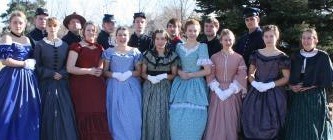
Lobo Mess, a Civil War living history club at Rocky Mountain High School in Ft. Collins. Photo by Joyce Bryant.
Several years ago, we attended a Civil War living history reenactment in Colorado. One highlight of the event was meeting a group of young women in period attire who we learned were students of Kurt Knierim, a social studies teacher from Rocky Mountain High School in Ft. Collins. They were also members of the school’s Civil War Living History Club dubbed Lobo Mess. (Lobo for the school mascot and mess for Civil War soldiers who ate together.)
I’ve been thinking about the impact living history has on young people of late, so I reached out to interview Knierim to get his insights from using living history to teach and motivate students.
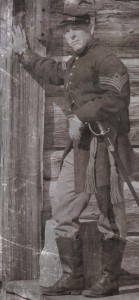
Kurt Knierim, award-winning educator, poses in uniform. Photo courtesy of Sean Papile.
As background, Knierim has been teaching at Rocky Mountain since 1992 and holds an honorarium faculty appointment in the history department at University of Colorado at Denver. He majored in history at Colorado State University and has earned Master’s degrees in education and American History. He was the 2010 Gilder Lehrman Institute for American History Teacher of the Year for Colorado. Not surprisingly, he also teaches “Secondary Social Studies Methods” for the History Department at Colorado State University.
Knierim’s Lobo Mess according to the school website is a “Civil War Living History independent study class…that allows high school students to take an active role in and present Civil War era living history.” It’s made presentations before “well over 10,000″ people” at “elementary schools, civic organizations, home school groups, television, museums, national parks, Colorado state parks, parades and battle reenactments.”
Where did you come up with the idea of getting students dressed in period clothes to do living history presentations?
I started participating in living history in 1997. From the beginning I was asked to visit schools and do presentations. By 2002, I had accumulated enough uniform parts to cobble together a second uniform. With uniform in hand, I asked one of my high school students to accompany me to a presentation at McGraw Elementary School. In preparation for the school visit, I taught the student the basics of the School of the Soldier and thus began what would become the Lobo Mess.
What’s the School of the Soldier, and what do you include in yours ?
It was the “basic training” that was included in the first part of every drill manual from the period. I use a blend of Hardee’s 1855 manual as well as Casey’s 1862 manual. I feel it is important for the students to be proficient at the basics of drill because it allows them to function as soldiers and affords them opportunities to “fall in” with other groups.
(Note: William Joseph Hardee resigned from his post at West Point to join the Confederacy at the beginning of the Civil War. His tactics manual was used by both sides during the war. The Hardee Hat, named for the General, was also used by both sides, most famously by the Union’s Iron Brigade. Silas Casey was a Union general during the war. Both were career military men.)
What difference has your approach made?
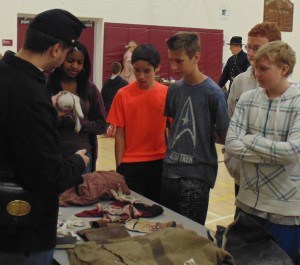
A Lobo Mess member explains Civil War paraphernalia to middle school students. Photo by Gabrielle Wymore.
There are three benefits I have seen with the club.
First, the club is students presenting to students. There are not many other models of clubs besides maybe “reading buddies” that pair students with students to teach and learn.
Second, it has produced public speaking confidence for the members of the Mess. It is wonderful to see the transformation from rather shy students who love history into young adults that don’t think twice before presenting to upwards of 100 students at a time.
Third, it provides students a way to experience history in ways they would not be able to in the regular classroom setting. By digging into research and “living out” their research, they gain knowledge and skills they will never forget.
What kind of feedback do you get from the club and living history?
Students seem to love it. I regularly have former “Messers” inquire about presentations, “crash” weekly meetings, and show up to events even years later.
In December (2014), current members of the “Mess” attended a Civil War ball–sponsored annually by the First Colorado Volunteer Infantry—in Denver. In addition to my current Messers, five others showed up, some having graduated as long ago as 2010.
Parents get so excited about it they sometimes tag along to presentations to see their kiddos in 1860s action.
The community has also been supportive. For the last six summers, we have partnered with the Fort Collins Discovery Museum (Local History Museum) to present for their “Wild West Days” summer program. In addition, the local history group, the Westerners, has invited us to present a couple times at their meetings. It’s also donated several hundred dollars to the club almost every year.
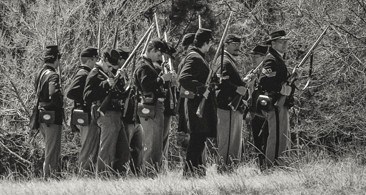
“Messers” join maneuvers near Red Rocks in Colorado. Photo courtesy of Stuart Lawrence.
We’re a long way from most reenactments. Do you get a chance to take students to very many reenactments?
We are a four-year high school, so I try to take a trip to a larger reenactment once every four years. Although we have gone as far as West Virginia (Battle of Rich Mountain), we usually head South to the Glorieta Pass reenactment near Santa Fe New Mexico in early May. I have also taken students to several NPS and State historic sites to do living history weekends.
How do these trips impact students?
Students get really excited about them. It really encourages them to stick with the hobby or even study history after high school.
One example would be Jim Bertolini who graduated in 2005. He continued to do living history for a number of years after high school and now has a Master’s in history. He currently is a historian in the State Historic Preservation Office for all of Nevada.
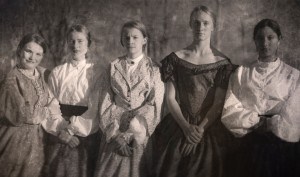
Club members, left to right, Ayrika Johnson, Monica Stauffer, Elle Chaffee, Katrin Sharpe and Nisa Rubio portray civilian ladies in photo taken by Lobo Mess member Sean Papile.
Tell us about what you personally do for the living history club.
I sponsor the club, which includes bringing in guest speakers and leading weekly meetings. I also aid the students in scheduling presentations, doing research for their presentations and arranging transportation to and from presentations and events.
What are your/their biggest obstacles?
We are always strapped for cash. We have more interest than ability to outfit students. Although we have a solid pool of material culture (9 infantrymen, 3-4 male civilians, and 7 ladies), there is always an issue of not having the right size of something or having to turn folks away because we cannot outfit them. Another obstacle is time. I always get many more requests for presentations than we have time for.
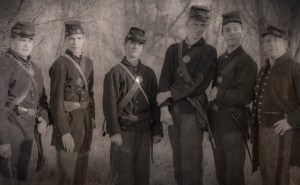
The soldiers of Lobo Mess, from left to right, Ben Colon-Bonet, Ryan Bolander, Nick AmRhein, Logan Haas, Bjorn Swenson and Kurt Knierim pose for a unit photo. Photo used by courtesy of Sean Papile.
How have you changed your approach over the years?
I have given over more and more to student leadership. Partly for practical reasons, and partly to build leadership. We also have every member put together at least one 10-15 minute “station” of interactive information to share at presentations.
Does this approach appeal only to students already interested in history, or do you attract students “new to history” as well?
We get all types. That is another strength of the club. We have the high flying AP crowd as well as the kids on Individualized Education Programs (IEP). This is great for the kiddos to have to get to know and work with students they would not ordinarily rub elbows with. Participating students are generally interested in the history, the material culture or the acting part of it.
Has interest and popularity of the class increased over time?
Yes, we have gone from one student to an average of about 15. Our biggest year, we had 20 and I had to turn kids away.
Are others picking up your approach?
I have had interest here and there, but without substantial monies for outfitting folks, there is not much chance of a club like this getting off the ground.
I’m sure it’s also crucial to have a dedicated teacher involved as well. Thanks Kurt Knierim. We hope your program continues to flourish and look forward to seeing you and your students at future living history reenactments.
The post Teaching with Living History in Schools: An Interview with Educator Kurt Knierim appeared first on Michael J. Roueche.



